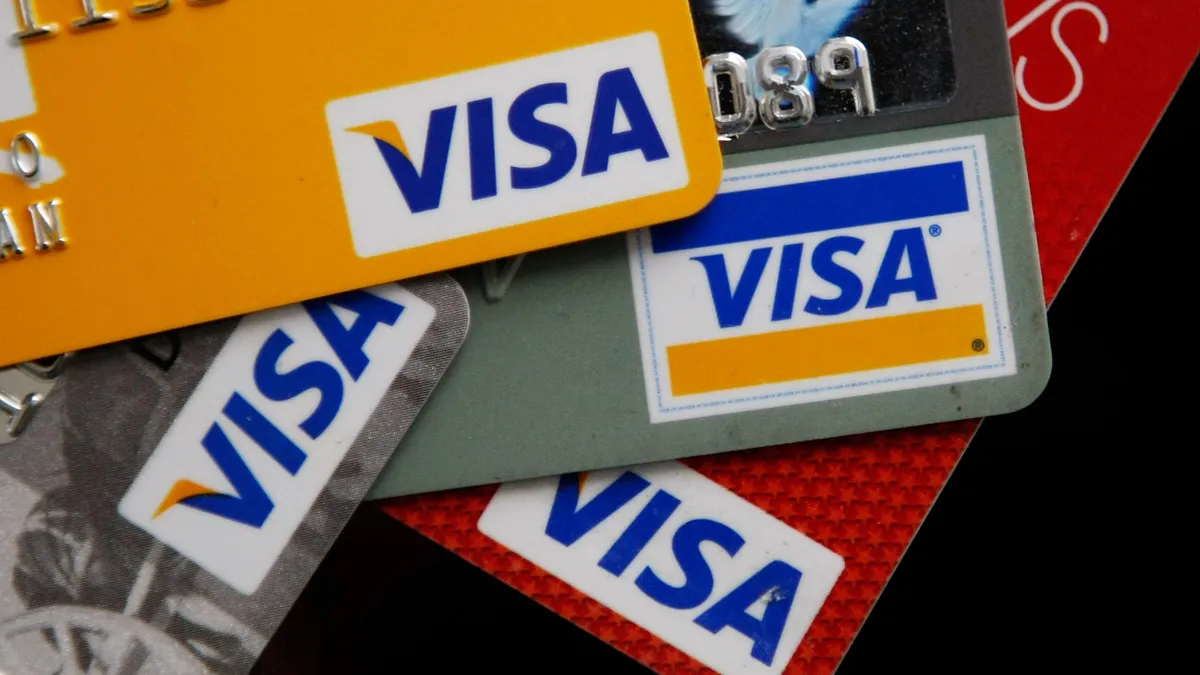Dive Brief:
- Visa, the largest U.S. credit card network company, sees plenty of future growth opportunity as payments digitization prompted by COVID-19 remains in an early stage, Visa Chief Financial Officer Vasant Prabhu said at recent investor conferences.
- Based on Visa’s calculations, the pandemic “brought forward one year’s worth of cash digitization,” Prabhu estimated while speaking earlier this month at the Bernstein Strategic Decisions Conference in New York City.
- Throughout the pandemic, Prabhu said more people around the world have adopted digital forms of payment, “because they realize they have to.” Merchants have realized their business depends on the ability to accept digital payments, “and the infrastructure for digital payments has gotten better just about everywhere,” he said last week.
Dive Insight:
Despite increased use of credit and debit cards and consumer cash use clocking in below 2019 levels, “this idea that the pandemic in some ways has reduced the future opportunity is very flawed,” Prabhu asserted at the Bernstein conference on June 2. “You’re talking about an ocean of cash,” and not just in emerging markets, he added.
He reiterated that perspective last week at another conference. “A little bit of the water has come out of the ocean, but you now have a machine that can take more water out every year,” he said when discussing the topic on June 7 at the Bank of America Global Technology Conference in San Francisco.
Prabhu said the “cash digitization engine” is a big driver of San Francisco-based Visa’s business, and it can help the company if there is any slowdown in consumer spending on the horizon. That threat has loomed lately as U.S. inflation climbed to a 40-year high and the Federal Reserve increased interest rates to cool the economy.
Goldman Sachs analysts also recently said cash-to-card conversion is in “middle innings,” not “late innings” in major economies, per The Wall Street Journal.
Earlier this year, Mizuho Securities Analyst Dan Dolev cast doubt on Visa’s growth potential, saying that since many consumers had already shifted from cash to card, there would be less opportunity to come for the card giant.
Other analysts have a different take. Oppenheimer Analyst Dominick Gabriele has called out the ongoing cash-to-card conversion opportunity for Visa. "We believe the company is well-positioned to benefit from the long-term secular shift from paper currency (cash/check) to plastic (electronic payments), consumer spending growth, and increased globalization,” he said in a December note to investors.
Prabhu on June 7 pointed to Visa’s payments volume in both Latin America and the Middle East/Africa regions doubling in the past three years. In India, payments volume is up about 80% since 2019. Meanwhile, personal consumption expenditures in those countries have “nowhere near doubled,” he said.
“What it tells you is there’s been a big swing towards digital payments,” Prabhu said.
In those markets, Visa has noticed “significant reductions” in habits such as cash withdrawal from ATMs and using that cash to make purchases, Prabhu said.
In the U.S., tap-to-pay with mobile phones hasn’t yet taken hold, Prabhu noted. He indicated he sees strong potential for that payment capability to further digitize transactions. “It becomes an engine for cash digitization,” he said. Visa also is logging more e-commerce transactions today than it did three years ago, thanks to the pandemic, he added.
“I don’t think there’s any constraints on growth from that standpoint,” Prabhu said.
More consumers plan to use digital payments this year, and small business owners see that payment ability as a growth driver, according to a Visa survey earlier this year.
India and Brazil are some of Visa’s fastest growing markets currently, Prabhu said. Those two countries also have national digital payment systems offering competition for Visa – UPI in India and Pix in Brazil – but Prabhu spun that as a benefit, since it’s fueling digital payment use and acceptance generally.
In developing markets, government involvement in digital payments is “good for the market,” he said. “It’s very hard for us to do on our own. When the government gets in, it can really give it a big boost.”
“We’d rather have a big chunk of a market that’s 10 times as big, than a bigger chunk of a market that’s 1/10th the size,” Prabhu added.















